
If you live somewhere on the Pacific Rim, you are no stranger to volcanic activity. In this photo, Peggy and I were inside a lava tube looking out at Lava Beds National Monument in northeastern California.
For those of us who call the Pacific Rim home, volcanic activity caused by plate tectonics is a part of our lives, whether we live in Oregon or Japan. Vast oceanic plates plunge under and slip along continental plates, virtually guaranteeing there will be an active or dormant volcano within a few hundred miles of where we live— and that we will feel the earth shake under us on occasion. The Pacific Ring of Fire, as it is known, contains 75% of the world’s active and dormant volcanoes and is responsible for approximately 90% of the world’s earthquakes.
Having spent most of my life in California, Oregon and Alaska, I am no stranger to these facts. I flew over Mt. St. Helens a couple of weeks after it blew its top and was stunned by the destruction. I’ve felt numerous earthquakes. Once, when I was staying in a mountain cabin in the Sierra Nevada Mountains, a minor earthquake struck 30 miles away and it sounded like a freight train was rumbling over our roof. So far, however, I have been fortunate to only witness exploding mountains and earth-shaking quakes at a safe distance. I prefer to keep it that way.
Lately, I confess, I’ve been a bit nervous whenever I make trips to the coast. There has been a lot of discussion recently about the Cascadian Subduction Zone that exists 70-100 miles off the shore; it’s subsiding. The oceanic Juan de Fuca Plate is moving eastward, slipping under the continental North American Plate. The next big earthquake is due, geologists claim, and it will be a doozy, a mother of all earthquakes reaching a magnitude 9 on the Richter Scale. Think of it this way, a level 6 earthquake is capable of doing considerable harm. A level 9 earthquake is one million times stronger.
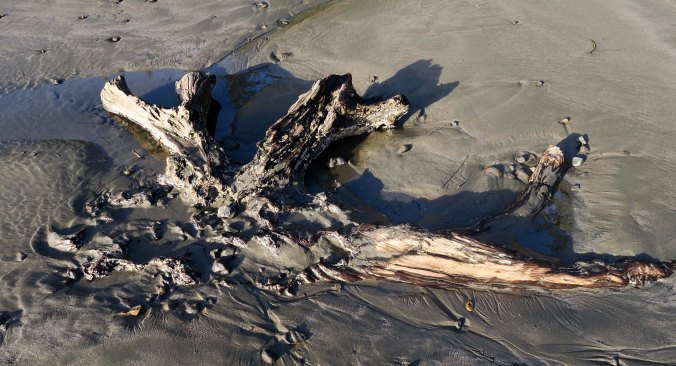
I found this root system of an ancient spruce at Sunset Bay on the Oregon Coast. The roots are all that are left after the last magnitude 9 earthquake sank major portions of the coast and covered the forests with water in 1700.
A huge (100-foot-high) tsunami has been projected. So, I’m always careful to check the tsunami escape routes when I am on the coast. If I am camping in my van and I feel the big shake, I am out of there, heading for higher ground with my power cord and hose dragging along behind. “No time to say hello-goodbye, I’m late, I’m late, I’m late!”
Substantial destruction is anticipated inland as well. We’ve been told that the Applegate Reservoir Dam above us might go. It’s only a mile away. Even though we are a couple of hundred feet above the river, our house is predicted to be right on the edge of where the raging waters would reach. Of course, whatever happens could be 50 years into the future. The science of predicting volcanic eruptions and earthquakes is improving but it is still far from exact.
Whether we ever experience the BIG one or not, there are numerous examples of the power of plate tectonic activity in Northern California, Oregon and Washington. Lava Beds National Monument in northern California is one. Minus tsunamis, it’s a great place to explore different types of volcanic activity. Peggy and I stopped off there this summer to check out Native American rock art found in the area.
The lava beds were created by lava moving across the area from the nearby Medicine Lake shield volcano. Shield volcanos are known for their highly liquid lava that prefers flowing to exploding, and Medicine Lake Volcano has flowed a lot in the last 500,000 years— generating some 140 cubic miles of lava covering 770 square miles. Lava Beds National Monument sits on the north slope of the volcano. A number of small cinder cone volcanoes dot the region. These smallest members of the volcano family are built up by blobs of congealed lava blown out of a single vent.
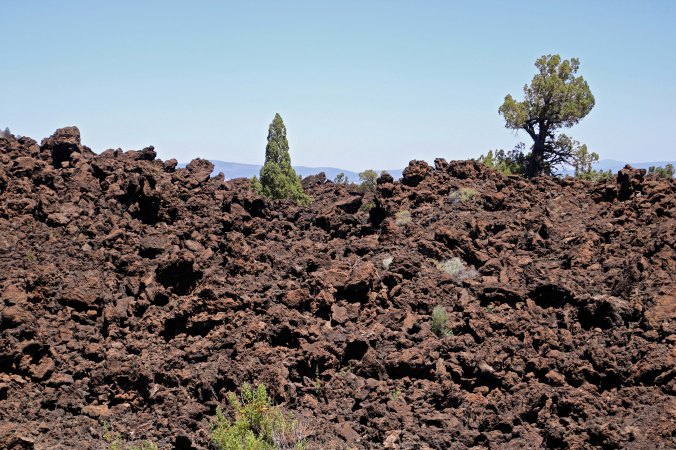
Rugged lava flow at Lava Beds National Monument. (Photo by Peggy Mekemson.)
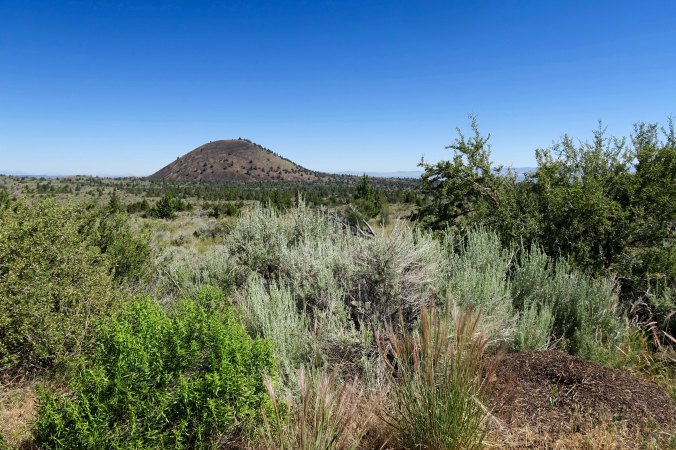
A cinder cone stands out on the horizon at Lava Beds National Monument. The grey plants in the foreground are sagebrush, a common plant of the drier parts of the West.
Mount Shasta towers above the area in the distance. Unlike its neighboring Medicine Lake Volcano, Mt. Shasta is a composite volcano made up of more viscous lava— the type that cools more quickly, likes to erupt, and forms steep sides. It is one of the most beautiful mountains in the Cascade chain of volcanoes that extends from northern California up to Canada. I climbed to its 14,175 peak once with a 76-year-old friend of mine, Orvis Agee. He was known fondly as ‘The Old Man of the Mountain’ since he had climbed it so many times. Climbing was tough; coming down was easier since we slid a thousand or so feet on our butts through the snow, using our ice axes as rudders and brakes.
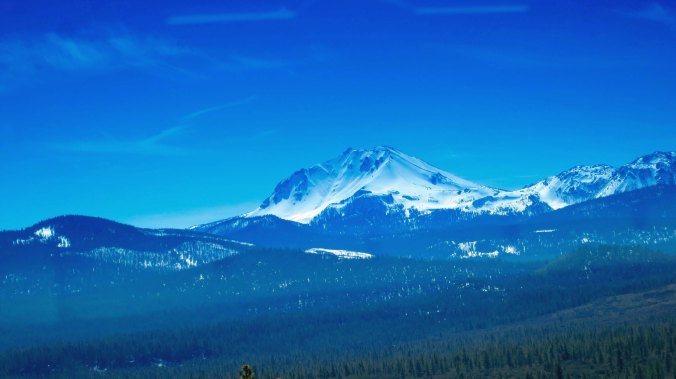
Mt. Shasta seen from the distance.
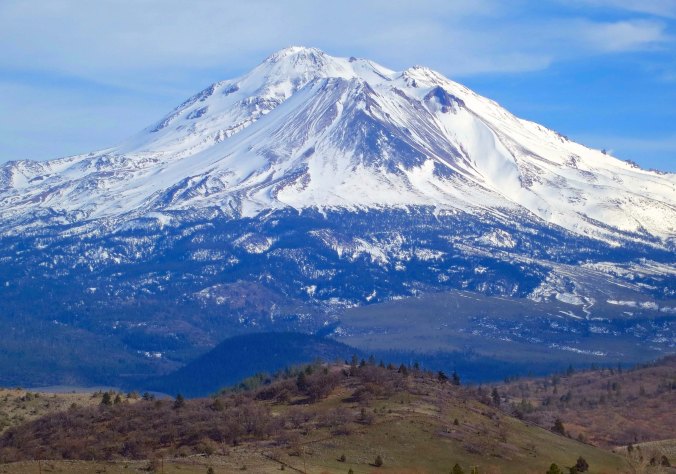
A closer perspective of Mt. Shasta, one of the most striking mountains in the Cascade chain.
Lava Beds National Monument is particularly noted for its lava tubes. These cave-like structures were created by lava flows in the last 10,000-60,000 years. As the lava cooled and hardened on the top and sides, it continued to flow through tunnels underneath the surface. When the source of the lava ran out, the remaining lava flowed out of the tunnels, leaving the tubes behind, some 700 of them.
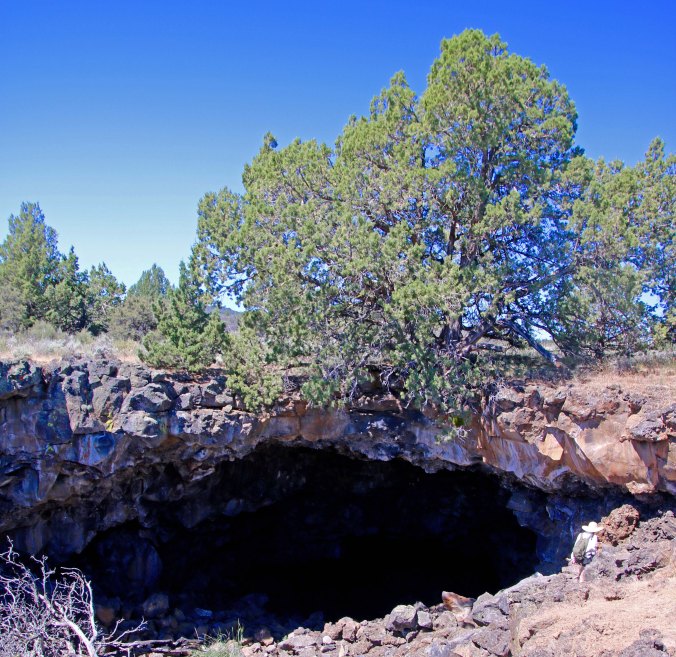
The mouth of a lava tube in Lava Beds National Monument. (Photo by Peggy Mekemson.)

And another. (Photo by Peggy Mekemson.)

This photo taken by Peggy provides perspective on the possible size of the lava tubes.

Numerous collapsed lava tubes are found at the Monument. (Photo by Peggy Mekemson.)
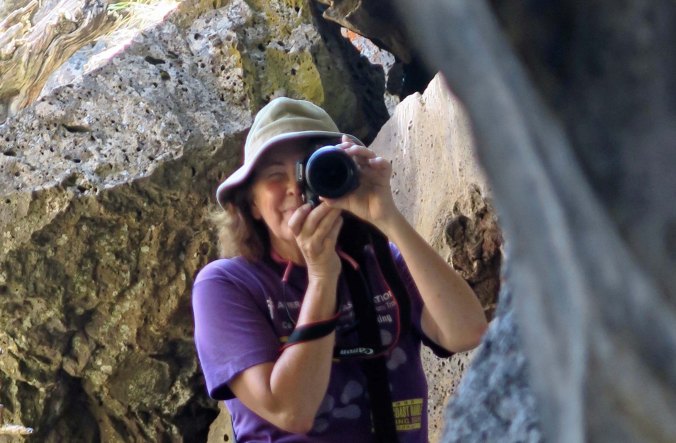
Peggy taking photos at the entrance to one of the lava tubes.
Humans have occupied the area for thousands of years. Paleolithic peoples found the tubes a refuge from the weather and a site for sacred ceremonies. The Modoc Indians used them as a hideout during the Modoc War of 1872-73. The Modocs had considered the area home for generations when white settlers arrived in the area and insisted that the natives be rounded up and shipped off to reservations so they could take over their land. One of the chiefs, Keintpoos, or Captain Jack as he was known by the settlers, found reservation life intolerable and returned to his homeland and hid out among the rugged lava and caves with a small band of warriors. It took a thousand soldiers over six months at considerable expense and loss of life to dislodge the 60 warriors. Captain Jack’s Stronghold is reserved as part of the Monument.

This rugged country including large volcanic rocks enabled Captain Jack to hide out from the American soldiers and fight back for six months.

Peggy and I found native swallows nesting near Captain Jack’s stronghold. They attacked us for disturbing their homes.
Settlers and their descendants found other uses for the lava tubes including an ice skating rink and a great place to hide out and make moonshine during the Prohibition Era. Drinking moonshine and ice skating together is not recommended. Lava Beds National Monument was established in 1925.
Today, visitors are welcome to explore the lava tubes. Many are spacious and short; others require sliding along on your bellies through tight spaces. Having a bit of claustrophobia, I avoid the latter. Since Peggy and I wanted to check out Native American Rock Art at the Monument on our visit this summer, we headed out to Symbol Bridge and Big Painted Cave, two lava tubes noted for the pictoglyphs. First we had to be screened for white-nose syndrome, however, which sounds like a rather nasty disease of people with white noses, but is actually a serious fungal disease that has been rapidly wiping out bat populations in North America and around the world. Since the lava tubes house a substantial population of bats, the park staff wanted to know if we were wearing “boots or other gear used in caves or mines outside of Lava Beds since 2006, or in caves or mines outside of the United States ever.” We hadn’t and were given a little sticker saying we passed inspection. Following are some of the pictoglyphs we found.

This rock contained numerous pictoglyphs that are actually painted on the rocks. While we don’t know for sure what the rock art represents, I would guess a person, plant life, storms and vaginas.
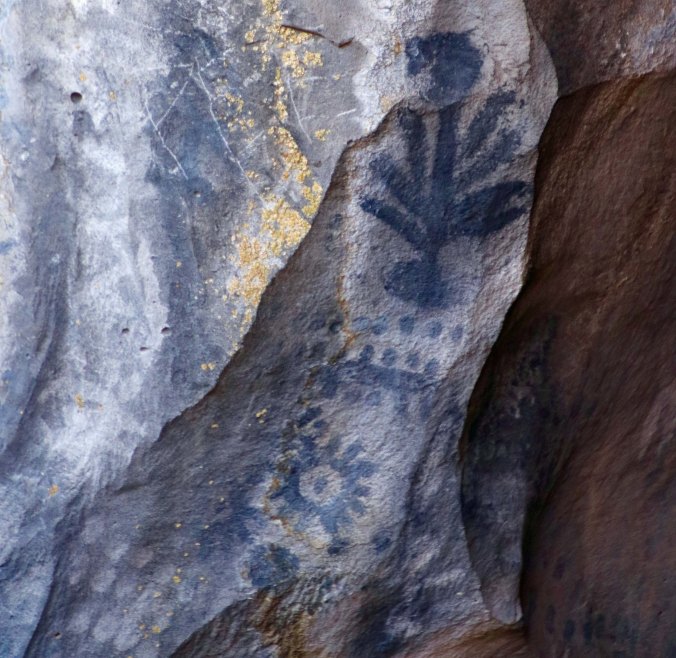
A plant, the sun and possibly some type of counting system to keep track of time. (Photo by Peggy Mekemson.)

My last example for the day. More suns? An animal and who knows? This rock art appears to have been finger painted on to the rocks. (Photo by Peggy Mekemson.)
NEXT POST: While the rock art at the entrance to the lava tubes seemed limited, this wasn’t the case at nearby Petroglyph Point where over 5000 images were carved into the rock on what was once an island in Tule Lake. My next post will feature the rock art from this location that was obviously a very sacred place to the Modoc and earlier native people, possibly going back 5,000 years.

You really have seen the sights, Curt! Loved the reference to the Modocs!! 🙂
It was the last Indian skirmish in California, G. In terms of numbers of soldiers involved, it reminded me of the efforts to corral Geronimo. –Curt
Ohio may be dull in many ways (though it has its own beauty and is very pretty in the fall), at least earthquakes and volcanic eruptions are things we don’t typically have to worry about. Tornadoes and floods, on the other hand, are a different story. I think we’re all at risk of those, especially with the changing climate.
Not many tornados out this way, Carrie, although there has been an increase in the number we see. At least it seems that way. They don’t like the type of mountains we live in, however. And you are right, earthquakes are few and far between in Ohio! Still, there is always a chance of a big one in the midwest. –Curt
Hopefully I’ll be traveling when it hits. 😉
We are living fairly high up and there are no dams above us. The compound we live at does pay a premium for being covered by earthquakes. I suppose the biggest danger is bush-fire and each year we clear out our gutters and leaf debris from gardens.
I love those lava caves, Curt. Somewhere to take shelter during a storm.
Sounds like you live in earthquake country as well, Gerard. Looking at you earthquake records, it looks like the most devastating have been in the 5.5 to 6.5 magnitude level. As I noted on my post a level 6 earthquake can do a lot of damage!
Like you, we worry more about fires, as we should given this summer’s evacuation. Still the Cascadia quake could change our attitude within seconds!
The lava caves also provide a break from the hot sun in the summer! –Curt
Fascinating & excellent photos!
Thanks, Cindy. A very interesting area.
I suppose the Big One is always sleeping way at the back of the mind of most Vancouverites (and area) too. We used to have an earthquake preparedness kit, but it went when we sold all our stuff. Although our home in Van is quite far from the coast it’s probably not far enough.
Fascinating about the lava tubes. What a great place to go exploring.
Coming down Mt Shasta sounds like way too much fun!
Alison
The Cascadia Subduction Zone marches right up the coast to Canada, Alison. Although it looks like you might have a bit of protection from Vancouver Island, I’m pretty sure that a major tsunami would work its way around it!
The caves are quite interesting. As for the slide down the mountain, it is still fresh in my memory banks even though I did it a long time ago 🙂 –Curt
Yeah, indeed the pacific rim is an actively moving part of mother earth. It has actually been a little more active recently, judging by the number of volcanoes in Indonesia that are stirring to life. So precautions are absolutely necessary.
The second entrance to the lava tube looked like a dinosaur’s mouth with teeth!
The Cascadia earthquake, when it happens, may be other example.
Laughed about the dinosaur mouth. Peggy and I had both had the same idea about the ‘teeth.’ –Curt
Wow! Fantastic post, Curt and I have feel my brain whizzing with this geographical and historical lesson!😀😀 I never knew there were volcanoes in California and the mountain is stunning…that must have been the best ‘non-sledge’ ride ever! I’m so taken with the lava tubes and it was a good idea to have Peggy in the photo to give a sense of perspective. The rock art reminds me of the rock carvings in Sweden, although these were ‘hammered’ into the solid granite. Wondrous glorious landscape…just awe inspiring! 😀
Thanks, Annika. Shasta and Lassen are the main volcanoes in California, but there are plenty of other examples. The plates moving around have left their volcanic legacy throughout California.
And the quick ride down the mountain was a kick. Fortunately, we had Orvis along for advice. 🙂
Peggy and I have been fascinated with rock art for a long time, wherever we find it. There were petroglyphs carved into the granite near where I was backpacking this summer. The ones I will feature in my next blog were carved into the much softer volcanic tuff. I know where I would prefer to create my rock art. 🙂 –Curt
A beautiful and rather dramatic landscape. Love how plants eventually return to such inhospitable earth.
The power of nature always amazes me, AC. The pine trees growing in the middle of the rocky desolation is a great example. –Curt
Your posts always cover plenty of territory – landscapes, both inner and outer, you could say – and this really connects your subjects and brings them to life. Hope the earthquakes and volcanos snooze on for a while though nature won’t ever be tamed …
Thanks, Dave. As for Mother Nature; she’s going to do what she’s going to do. All we can do is prepare. Plus I would rather trust her than a lot of our national leaders these days. –Curt
Tell you what, Curt, for some reason this puts me in mind of King Lear up against the elements. Please excuse a bit from the Bard:
Blow, winds, and crack your cheeks! rage! blow!
You cataracts and hurricanoes, spout
Till you have drench’d our steeples, drown’d the cocks!
You sulphurous and thought-executing fires,
Vaunt-couriers to oak-cleaving thunderbolts,
Singe my white head! And thou, all-shaking thunder,
Smite flat the thick rotundity o’ the world!
Crack nature’s moulds, an germens spill at once,
That make ingrateful man!
Fool
O nuncle, court holy-water in a dry
house is better than this rain-water out o’ door.
Good nuncle, in, and ask thy daughters’ blessing:
here’s a night pities neither wise man nor fool.
KING LEAR
Rumble thy bellyful! Spit, fire! spout, rain!
Nor rain, wind, thunder, fire, are my daughters:
I tax not you, you elements, with unkindness;
I never gave you kingdom, call’d you children,
You owe me no subscription: then let fall
Your horrible pleasure: here I stand, your slave,
A poor, infirm, weak, and despised old man:
But yet I call you servile ministers,
That have with two pernicious daughters join’d
Your high engender’d battles ‘gainst a head
So old and white as this. O! O! ’tis foul!
These pictures of the lava tubes are so intriguing. I’d love to climb around inside one. Volcanoes have always fascinated me, but maybe that’s partly because I’m nowhere near one.
Hope you and Peggy always stay safe! Mother Nature is not a force to be reckoned with.
I included another two in today’s post Juliann. I’d misplaced them. I’ve experienced a lot of Mother Nature over the years. So far so good. I think she has something to offer to just about anyone, anywhere. 🙂 Thanks. –Curt
As always I learn a lot. Thank you.
Glad you enjoy it, Jane. Peggy and I learn right along with you. –Curt
It took me a long time to figure out what that third photo of the lava flow reminded me of. It’s the cinders they used to use as ballast along rail lines. Look at the section labeled “Mile 7” from a book titled The Railroad and the Canyon. I don’t know whether they’re still using cinder or if they’ve moved completely to gravel. The next time I run into one of the Southern Pacific guys who floats around here, I’ll try to remember to ask.
In my youth, Linda, I often found myself hiking along SP tracks, since they provided shortcuts to where I wanted to go. They were also a great source of rocks for my rock collection. I’d come home with my pants almost falling off from the rocks that I had stuffed in my pockets. And yes, they used volcanic cinder quite often. I’ve seen it many times since as well, but not sure of the last time. One of the fun things about it is that it is a rock that floats! –Curt
Wow – this post is chock-full of information, amazing photos, and scary stuff! The mere idea of a tsunami freezes my blood, and those lava tube mouths look like their toothy jaws are just waiting to swallow me. I guess I live in a climactically dangerous zone myself, but the west coast really would give me pause with the earthquake possibilities.
Those hurricanes keep rolling onto the Gulf Coast. So I would say that you are climactically challenged as well! Tsunamis and earthquakes come with the territory out here, as do the forest fires. My goal is to avoid them as much as possible. Having to evacuate our home this summer was getting a little too close to home! –Curt
Thank you for the post, I will have to add this to my to do list for my next trip down that way! Reminds me a bit of hiking in the Cascades in Oregon, which I really enjoyed despite the ruggedness of the terrain. It’s interesting to imagine what the world would have been like back when those geological events took place. 🙂
The Cascades offer a lot of interesting hiking country! Although I’ve done most of mine in the Sierras.
I’d think Mt. St. Helens blowing its top provided a review! And lets just hope we don’t experience the Cascadia earthquake, Snuffy. 🙂 Thanks for commenting. –Curt
Pingback: Friday Faves 11/17/2017 – Must Hike Must Eat
Thanks for the link. Much appreciated. –Curt
The earth’s plates are definitely moving and I would be uncomfortable to be close to a subduction or slippage zone, but as you say it could be next month or in 100 year’s time… we are just ants and our time scales are petty from the earth’s point of you.
I have found, Hillary, that all of the information on the Cascadian Subduction zone has made me more cautious on my trips to the coast. I’m always looking for the high ground. 🙂 –Curt